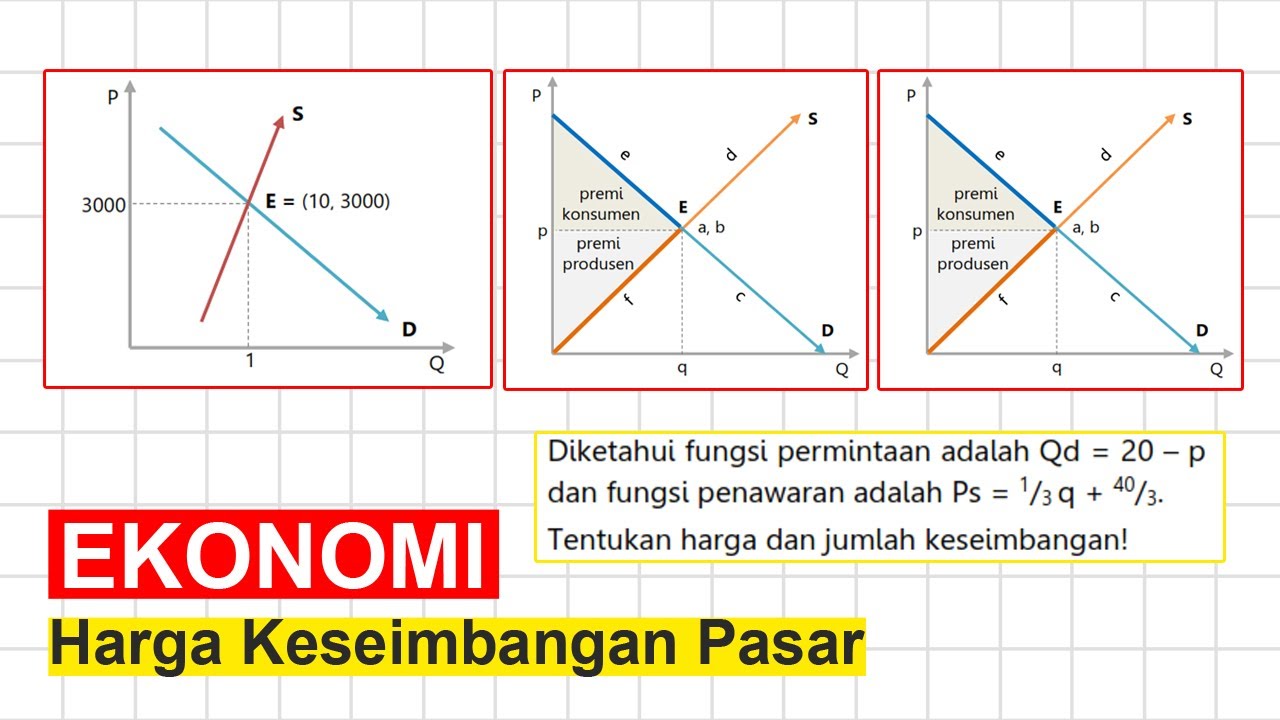PERMINTAAN | EKONOMI X
Summary
TLDRThis economics class covers fundamental concepts of demand and supply, focusing on how market equilibrium is formed through the interaction of buyers and sellers. The lecture explains the law of demand, highlighting the inverse relationship between price and quantity demanded, and introduces the demand curve. It also explores factors affecting demand, including the price of related goods, consumer income, preferences, and expectations. The session concludes with a mathematical approach to understanding the demand function, offering students practical insights into real-world economic dynamics.
Takeaways
- 😀 The lesson focuses on demand and supply, fundamental concepts in economics for high school students.
- 😀 Price equilibrium is formed through the interaction of supply and demand, determining the market price.
- 😀 Demand refers to the quantity of goods or services consumers are willing to buy at different prices.
- 😀 Effective demand occurs when consumers have both the desire and financial ability to buy a good or service.
- 😀 Potential demand refers to consumers who desire a good but have not yet made a purchase.
- 😀 Absolute demand refers to situations where consumers cannot afford to buy a good, regardless of their desire.
- 😀 The Law of Demand states that as prices rise, demand decreases, and as prices fall, demand increases, ceteris paribus.
- 😀 The demand curve shows the relationship between the price of a good and the quantity demanded, typically sloping downward.
- 😀 Movements along the demand curve occur when the price changes, while shifts in the curve are caused by factors like income or preferences.
- 😀 Factors influencing demand include the price of related goods (substitutes and complements), consumer income, preferences, and future expectations.
- 😀 Substitutes and complements are important in understanding how price changes in one good can affect the demand for another.
- 😀 Consumer income levels influence demand, with higher income generally leading to increased demand for goods and services.
- 😀 Consumer preferences and expectations about future price changes can shift demand either to the right (increase) or left (decrease).
Q & A
What is the main topic discussed in this economics lesson?
-The main topic discussed is demand, a key concept in economics, along with its law, types, and factors that influence it.
How is market equilibrium formed according to the script?
-Market equilibrium is formed through a process of agreement between sellers and buyers, where the price and quantity of goods meet at a point of balance.
What is the definition of 'demand' in economics?
-Demand refers to the quantity of goods or services that consumers are willing and able to purchase at various prices over a certain period of time.
What are the three types of demand mentioned in the script?
-The three types of demand are effective demand (when consumers have both the desire and financial ability to buy), potential demand (when consumers desire the good but lack the means), and absolute demand (when consumers neither desire nor have the means to buy).
What does the 'law of demand' state?
-The law of demand states that as the price of a good rises, the quantity demanded falls, and as the price of a good falls, the quantity demanded increases.
What does the demand curve represent?
-The demand curve represents the relationship between the price of a good and the quantity demanded. It typically slopes downward from left to right, indicating that lower prices lead to higher demand.
What is the difference between a 'movement' and a 'shift' in the demand curve?
-A movement along the demand curve occurs when the price of the good changes, affecting the quantity demanded. A shift in the demand curve happens when factors other than price (such as income or consumer preferences) change, leading to an increase or decrease in demand.
What are some factors that can shift the demand curve?
-Factors that can shift the demand curve include the price of related goods (substitute and complementary goods), consumer income, consumer preferences, and expectations about future prices.
What is the role of substitute goods in demand?
-Substitute goods are products that can replace one another. When the price of one good increases, consumers may switch to a cheaper substitute, thus increasing the demand for the substitute.
How does consumer income affect demand?
-As consumer income increases, demand for normal goods tends to rise because consumers have more purchasing power. Conversely, demand for inferior goods may decrease as income rises, as consumers switch to higher-quality alternatives.
Outlines

Cette section est réservée aux utilisateurs payants. Améliorez votre compte pour accéder à cette section.
Améliorer maintenantMindmap

Cette section est réservée aux utilisateurs payants. Améliorez votre compte pour accéder à cette section.
Améliorer maintenantKeywords

Cette section est réservée aux utilisateurs payants. Améliorez votre compte pour accéder à cette section.
Améliorer maintenantHighlights

Cette section est réservée aux utilisateurs payants. Améliorez votre compte pour accéder à cette section.
Améliorer maintenantTranscripts

Cette section est réservée aux utilisateurs payants. Améliorez votre compte pour accéder à cette section.
Améliorer maintenantVoir Plus de Vidéos Connexes

Harga Keseimbangan Pasar / Ekuilibrium Pasar - EKONOMI

EconMovies #4: Indiana Jones (Reupload)

Proses Terbentuknya Harga Pasar | Ekonomi Kelas X - KHATULISTIWA MENGAJAR

Proses terbentuknya harga pasar l Eduraya Mengajar

Permintaan, Penawaran, dan Pasar - Video IPS Kelas 7

Macro 1.6 - Market Equilibrium - NEW!
5.0 / 5 (0 votes)
